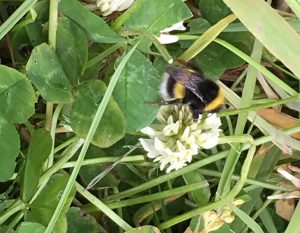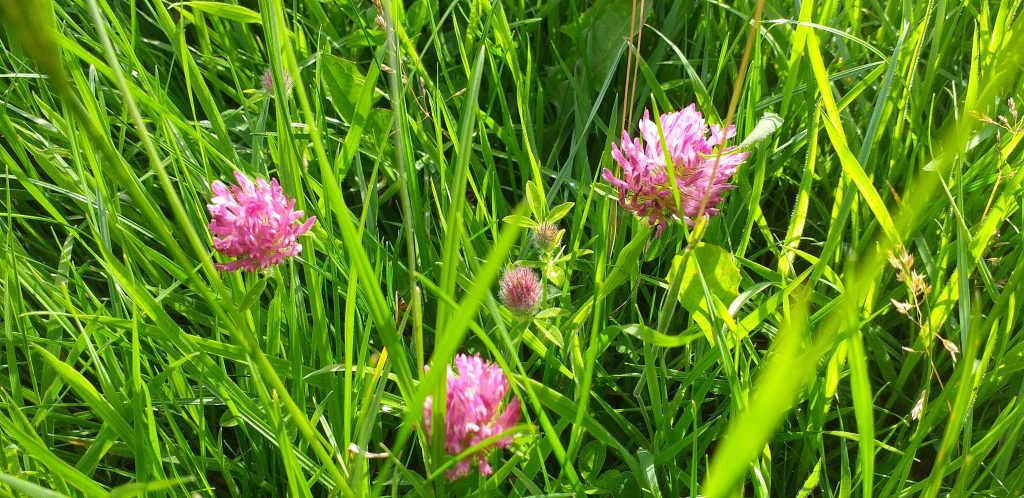Keeping clover in your reseed
July 16, 2020
Jayne Mooney, CAFRE Biodiversity Technologist
Clover forms a useful addition to a grass sward. In addition to reducing the need for artificial fertiliser and its high feed value, clover also provides an impressive pollen and nectar resource for beneficial insects. However clover swards are at risk from some herbicides if weeds need to be controlled.
“If you have invested in reseeding using a grass/clover seed mix, the range of herbicides available for treating swards to maintain clover safely is much reduced compared to pure grass swards. As spraying also has risks associated with a negative impact on beneficial insects, and water quality it is worth firstly considering how weeds can be effectively controlled by other measures such as ‘topping’ or grazing.
CAFRE Biodiversity technologist Jayne Mooney
Grazing, preferably with sheep, when the grass is 10 cm tall, can provide a useful degree of control of annual weeds such as chickweed, redshank and hemp nettle. However, care must be taken to avoid overgrazing and poaching, especially when soil conditions are wet.
In direct-sown swards, or swards undersown with an arable silage crop, ‘topping’ or forage harvesting can control most annual broad-leaved weeds, except chickweed which spreads and smothers below cutting height.
Spot spraying larger weeds such as docks and thistles rather than spraying the whole sward uses considerably less plant protection product and therefore reduces the potential risk of water pollution. If docks are a particular problem, a programmed approach works best with either spring treatment followed by autumn treatment or vice versa, being careful to adhere to the maximum annual dosage rate for the product used. If larger populations of docks are present, a full rate treatment in the autumn followed by another full rate treatment in spring can be more effective.
Jayne added, “If the whole sward requires spraying for weed control, a clover safe herbicide should be used. Always follow the manufacturers’ instructions carefully to avoid damage to newly sown clover or established clover. Whilst clover safe sprays can be more expensive the additional benefits of clover will always outweigh this cost.”

Clover safe sprays for reseeds
There are three active herbicide ingredients for use on reseeds that are recognised as having a reduced or minimal impact on clover, i.e. growth may be checked but recovery is likely.
Tribenuron methyl – This controls chickweed and seedling dock but it may check clover growth. Application should take place from the three leaf stage of grass and one to two trifoliate leaves of the clover. It can be a slow kill, particularly under cool, dry conditions. An example proprietary name is ‘Triad’.
2. Amidosulfuron -This controls broad leaved and curled docks and non-resistant chickweed. Avoid using Amidosulfuron on grass swards containing red clover. It can be applied from the three leaf stage of the grass and one to two trifoliate leaves of the clover. Do not graze for seven days after treatment and leave 21 days before cutting or grazing. An example proprietary name is ‘Squire Ultra’.
3. 2,4-DB -This controls buttercup, fat hen, seedling docks and thistles from seed but it may check clover growth. It is a common tank-mix partner with ‘Triad’ to give broader weed control. Apply at seedling stage when weeds are growing rapidly. Example proprietary names are ‘Headland Spruce’, ‘Clovermaster’, and ‘DB Straight’.
For established swards there are two main active ingredients termed as clover safe namely Thifensulfuron methyl, and Amidosulfuron. They are both more effective applied to weed regrowth rather than mature plants. Where red clover is part of the sward only Thifensulfuron methyl should be used. An example proprietary names is “Pinnacle”.
In addition some products containing MCPB or 2, 4-DB + MCPA can be used in reseeds or established swards. Their latest time of application is usually dependent on weed size, except MCPB which must not be applied to red clover once the flower stalk has begun to form.

In reseeds chemical control of annual weeds is best achieved as soon as possible, when the grass and/or clover has reached the herbicide tolerance stage (usually 2-3 leaves, check carefully individual product labels). Weeds become more difficult to control as they increase in size. The application timing will then depend on the size of the weeds and the growing conditions. In all cases if weeds are seeding/flowering, it is best to top and then treat the regrowth. For most products the best results will be achieved if the weeds are actively growing.
Before using any plant protection products consult a BASIS registered agronomist for the latest information on product availability and application advice. Anyone supplying plant protection products will have access to a BASIS qualified Adviser at the point of purchase, either directly or by phone. Always read the label and product information before use and adhere to label recommendations in regards to product application rate, cutting and grazing intervals etc.
All professional users of pesticide, including use for agricultural purposes, are legally required to have a Certificate of Competence in the Safe Use of Pesticides (PA1, PA2A Boom Sprayer, PA6A Knapsack etc.). Contact CAFRE Industry Training on 028 9442 6880 to register your interest on a PESTICIDE TRAINING COURSE.
